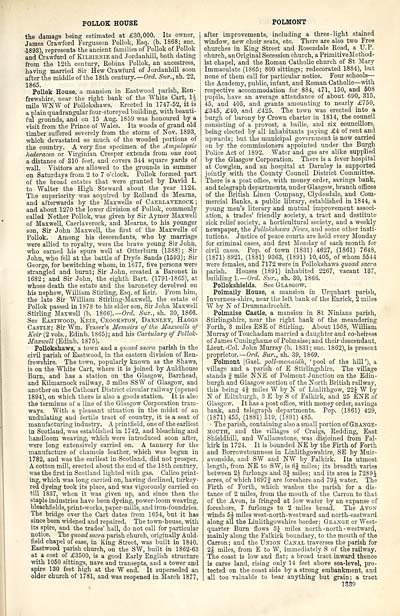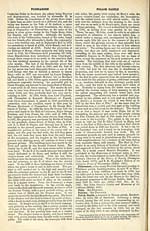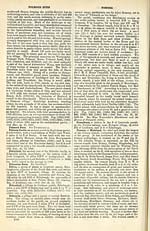Ordnance gazetteer of Scotland
(1347) Page 1339
Download files
Complete book:
Individual page:
Thumbnail gallery: Grid view | List view

POLLOK HOUSE
the damage being estimated at £30,000. Its owner,
James Crawford Fergusson Pollok, Esq. (b. 1868; sue.
■1893), represents the ancient families of Pollok of Pollok
and Crawford of Kilbirnie and Jordanhill, both dating
from the 12th century, Robina Pollok, an ancestress,
having married Sir Hew Crawfurd of jordanhill soon
after the middle of the 18th century.— Ord. Sur., sh. 22,
1865.
Pollok House, a mansion in Eastwood parish, Ren-
frewshire, near the right bank of the "White Cart, 1J
mile TOW of Pollokshaws. Erected in 1747-52, it is
a plain quadrangular four-storeyed building, with beauti-
ful grounds, and on 15 Aug. 1859 was honoured by a
visit" from the Prince of Wales. Its woods of grand old
timber suffered severely from the storm of Nov. 1893,
which devastated so much of the wooded portions of
the country. A very fine specimen of the Ampelopsis
hederacea or Virginian Creeper extends fi'om one root
a distance of 310 feet, and covers 344 square yards of
wall. Visitors are allowed to the grounds in summer
on Saturdays from 2 to 7 o'clock. Pollok formed part
of the broad estates that were granted by David I.
to "Walter the High Steward about the year 1124.
The superiority was acquired by Rolland de Mearns,
and afterwards by the Maxwells of Caerlaverock ;
and about 1270 the lower division of Pollok, commonly
called Nether Pollok, was given by Sir Aymer Maxwell
of Maxwell, Caerlaverock, and Mearns, to his younger
son, Sir John Maxwell, the first of the Maxwells of
Pollok. Among his descendants, who by marriage
were allied to royalty, were the brave young Sir John,
who earned his spurs well at Otterburn (1388) ; Sir
John, who fell at the battle of Dryfe Sands (1593); Sir
George, for bewitching whom, in 1677, five persons were
strangled and burnt; Sir John, created a Baronet in
1682; and Sir John, the eighth Bart. (1791-1865), at
whose death the estate and the baronetcy devolved on
his nephew, "William Stirling, Esq. of Keir. From him,
the late Sir "William Stirling-Maxwell, the estate of
Pollok passed in 1878 to his elder son, Sir John Maxwell
Stirling Maxwell (b. 1866).— Ord. Sur., sh. 30, 1866.
See Eastwood, Keir, Crookston, Darnley, Haggs
Castle; Sir Wm. Fraser's Memoirs of the Maxwells of
Keir (2 vols., Edinb. 1865); and his Cartulary of Pollok-
Maxwell (Edinb. 1875).
Pollokshaws, a town and a quoad sacra parish in the
civil parish of Eastwood, in the eastern division of Ren-
frewshire. The town, popularly known as the Shaws,
is on the "White Cart, where it is joined by Auldhouse
Burn, and has a station on the Glasgow, Barrhead,
and Kilmarnock railway, 3 miles SSW of Glasgow, and
another on the Cathcart District circular railway (opened
1894), on which there is also a goods station. It is also
the terminus of a line of the Glasgow Corporation tram-
ways. "With a pleasant situation in the midst of an
undulating and fertile tract of country, it is a seat of
manufacturing industry. A printfield, one of the earliest
in Scotland, was established in 1742, and bleaching and
handloom weaving, which were introduced soon after,
were long extensively carried on. A tannery for the
manufacture of chamois leather, which was begun in
1782, and was the earliest in Scotland, did not prosper.
A cotton mill, erected about the end of the ISth century,
was the first in Scotland lighted with gas. Calico print-
in", which was long carried on, having declined, turkey-
Ted dyeing took its place, and was vigorously carried on
till 1837, when it was given up, and since then the
staple industries have been dyeing, power-loom weaving,
bleachfields, print-works, paper-mills, and iron-foundries.
The bridge over the Cart dates from 1654, but it has
since been widened and repaired. The town-house, with
its spire, and the trades' hall, do not call for particular
notice. The quoad sacra parish church, originally Auld-
field chapel of ease, in King Street, was built in 1840.
Eastwood parish church, on the SW, built in 1862-63
at a cost of £3500, is a good Early English structure
with 1050 sittings, nave and transepts, and a tower and
spire 130 feet high at the W end. It superseded an
older church of 1781, and was reopened in March 1877,
POLMONT
after improvements, including a three -light stained
window, new choir seats, etc. There are also two Free
churches in King Street and Rosendale Road, a U.P.
church, an Original Secession church, a PrimitiveMethod-
ist chapel, and the Roman Catholic church of St Mary
Immaculate (1865; 800 sittings; redecorated 1884), but
none of them call for particular notice. Four schools —
the Academy, public, infant, and Roman Catholic — with
respective accommodation for 884, 471, 150, and 508
pupils, have an average attendance of about 690, 315,
45, and 405, and grants amounting to nearly £750,
£345, £40, and £425. The town was erected into a
burgh of barony by Crown charter in 1814, the council
consisting of a provost, a bailie, and six councillors,
being elected by all inhabitants paying £4 of rent and
upwards; but the municipal government is now carried
on by the commissioners appointed under the Burgh
Police Act of 1892. "Water and gas are alike supplied
by the Glasgow Corporation. There is a fever hospital
at Cowglen, and an hospital at Darnley is supported
jointly with the County Council District Committee.
There is a post office, with money order, savings bank,
and telegraph departments, under Glasgow, branch offices
of the British Linen Company, Clydesdale, and Com-
mercial Banks, a public library, established in 1844, a
young men's literary and mutual improvement associ-
ation, a trades' friendly society, a tract and destitute
sick relief society, a horticultural society, and a weekly
newspaper, the Pollokshaws News, and some other insti-
tutions. Justice of peace courts are held every Monday
for criminal cases, and first Monday of each month for
civil cases. Pop. of town (1831) 4627, (1861) 7648,
(1871) 8921, (1881) 9363, (1891) 10,405, of whom 5544
were females, and 7172 were in Pollokshaws quoad sacra
parish. Houses (1891) inhabited 2267, vacant 137,
building 1.— Ord. Sur., sh. 30, 1866.
Pollokshields. See Glasgow.
Polmaily House, a mansion in Urquhart parish,
Inverness-shire, near the left bank of the Enrick, 2 miles
W by N of Drumnadrochit.
Polmaise Castle, a mansion in St Ninians parish,
Stirlingshire, near the right bank of the meandering
Forth, 3 miles ESE of Stirling. About 1568, "William
Murray of Touehadam married a daughter and co-heiress
of James Cuninghame of Polmaise; and their descendant,
Lieut.-Col. John Murray (b. 1831; sue. 1862), is present
proprietor.— Ord. Sur., sh. 39, 1869.
Polmont (Gael, poll-monaidh, 'pool of the hill'), a
village and a parish of E Stirlingshire. The village
stands f mile NNE of Polmont Junction on the Edin-
burgh and Glasgow section of the North British railway,
this being 4f miles W by N of Linlithgow, 22J W by
N of Edinburgh, 3 E by S of Falkirk, and 25 ENE of
Glasgow. It has a post office, with money order, savings
bank, and telegraph departments. Pop. (1861) 429,
(1871) 455, (1881) 519, (1891) 485.
The parish, containing also a small portion of Grange-
mouth, and the villages of Craigs, Redding, East
Shieldhill, and Wallacestone, was disjoined from Fal-
kirk in 1724. It is bounded NE by the Firth of Forth
and Borrowstounness in Linlithgowshire, SE by Muir-
avonside, and SW and NW by Falkirk. Its utmost
length, from NE to SW, is 6 J miles; its breadth varies
between 2i furlongs and 3J miles; and its area is 7289 J
acres, of which 1697| are foreshore and 79 J water. The
Firth of Forth, which washes the parish for a dis-
tance of 2 miles, from the mouth of the Carron to that
of the Avon, is fringed at low water by an expanse of
foreshore, 7 furlongs to 2 miles broad. The Avon
winds 5£ miles west-north-westward and north-eastward
along all the Linlithgowshire border; Grange or West-
quarter Burn flows 3J miles north-north-westward,
mainly along the Falkirk boundary, to the mouth of the
Carron; and the Union Canal traverses the parish for
2J miles, from E to W, immediately S of the railway.
The coast is low and flat; a broad tract inward thence
is earse land, rising only 14 feet above sea-level, pro-
tected on the coast side by a strong embankment, and
all too valuable to bear anything but grain; a tract
1339
the damage being estimated at £30,000. Its owner,
James Crawford Fergusson Pollok, Esq. (b. 1868; sue.
■1893), represents the ancient families of Pollok of Pollok
and Crawford of Kilbirnie and Jordanhill, both dating
from the 12th century, Robina Pollok, an ancestress,
having married Sir Hew Crawfurd of jordanhill soon
after the middle of the 18th century.— Ord. Sur., sh. 22,
1865.
Pollok House, a mansion in Eastwood parish, Ren-
frewshire, near the right bank of the "White Cart, 1J
mile TOW of Pollokshaws. Erected in 1747-52, it is
a plain quadrangular four-storeyed building, with beauti-
ful grounds, and on 15 Aug. 1859 was honoured by a
visit" from the Prince of Wales. Its woods of grand old
timber suffered severely from the storm of Nov. 1893,
which devastated so much of the wooded portions of
the country. A very fine specimen of the Ampelopsis
hederacea or Virginian Creeper extends fi'om one root
a distance of 310 feet, and covers 344 square yards of
wall. Visitors are allowed to the grounds in summer
on Saturdays from 2 to 7 o'clock. Pollok formed part
of the broad estates that were granted by David I.
to "Walter the High Steward about the year 1124.
The superiority was acquired by Rolland de Mearns,
and afterwards by the Maxwells of Caerlaverock ;
and about 1270 the lower division of Pollok, commonly
called Nether Pollok, was given by Sir Aymer Maxwell
of Maxwell, Caerlaverock, and Mearns, to his younger
son, Sir John Maxwell, the first of the Maxwells of
Pollok. Among his descendants, who by marriage
were allied to royalty, were the brave young Sir John,
who earned his spurs well at Otterburn (1388) ; Sir
John, who fell at the battle of Dryfe Sands (1593); Sir
George, for bewitching whom, in 1677, five persons were
strangled and burnt; Sir John, created a Baronet in
1682; and Sir John, the eighth Bart. (1791-1865), at
whose death the estate and the baronetcy devolved on
his nephew, "William Stirling, Esq. of Keir. From him,
the late Sir "William Stirling-Maxwell, the estate of
Pollok passed in 1878 to his elder son, Sir John Maxwell
Stirling Maxwell (b. 1866).— Ord. Sur., sh. 30, 1866.
See Eastwood, Keir, Crookston, Darnley, Haggs
Castle; Sir Wm. Fraser's Memoirs of the Maxwells of
Keir (2 vols., Edinb. 1865); and his Cartulary of Pollok-
Maxwell (Edinb. 1875).
Pollokshaws, a town and a quoad sacra parish in the
civil parish of Eastwood, in the eastern division of Ren-
frewshire. The town, popularly known as the Shaws,
is on the "White Cart, where it is joined by Auldhouse
Burn, and has a station on the Glasgow, Barrhead,
and Kilmarnock railway, 3 miles SSW of Glasgow, and
another on the Cathcart District circular railway (opened
1894), on which there is also a goods station. It is also
the terminus of a line of the Glasgow Corporation tram-
ways. "With a pleasant situation in the midst of an
undulating and fertile tract of country, it is a seat of
manufacturing industry. A printfield, one of the earliest
in Scotland, was established in 1742, and bleaching and
handloom weaving, which were introduced soon after,
were long extensively carried on. A tannery for the
manufacture of chamois leather, which was begun in
1782, and was the earliest in Scotland, did not prosper.
A cotton mill, erected about the end of the ISth century,
was the first in Scotland lighted with gas. Calico print-
in", which was long carried on, having declined, turkey-
Ted dyeing took its place, and was vigorously carried on
till 1837, when it was given up, and since then the
staple industries have been dyeing, power-loom weaving,
bleachfields, print-works, paper-mills, and iron-foundries.
The bridge over the Cart dates from 1654, but it has
since been widened and repaired. The town-house, with
its spire, and the trades' hall, do not call for particular
notice. The quoad sacra parish church, originally Auld-
field chapel of ease, in King Street, was built in 1840.
Eastwood parish church, on the SW, built in 1862-63
at a cost of £3500, is a good Early English structure
with 1050 sittings, nave and transepts, and a tower and
spire 130 feet high at the W end. It superseded an
older church of 1781, and was reopened in March 1877,
POLMONT
after improvements, including a three -light stained
window, new choir seats, etc. There are also two Free
churches in King Street and Rosendale Road, a U.P.
church, an Original Secession church, a PrimitiveMethod-
ist chapel, and the Roman Catholic church of St Mary
Immaculate (1865; 800 sittings; redecorated 1884), but
none of them call for particular notice. Four schools —
the Academy, public, infant, and Roman Catholic — with
respective accommodation for 884, 471, 150, and 508
pupils, have an average attendance of about 690, 315,
45, and 405, and grants amounting to nearly £750,
£345, £40, and £425. The town was erected into a
burgh of barony by Crown charter in 1814, the council
consisting of a provost, a bailie, and six councillors,
being elected by all inhabitants paying £4 of rent and
upwards; but the municipal government is now carried
on by the commissioners appointed under the Burgh
Police Act of 1892. "Water and gas are alike supplied
by the Glasgow Corporation. There is a fever hospital
at Cowglen, and an hospital at Darnley is supported
jointly with the County Council District Committee.
There is a post office, with money order, savings bank,
and telegraph departments, under Glasgow, branch offices
of the British Linen Company, Clydesdale, and Com-
mercial Banks, a public library, established in 1844, a
young men's literary and mutual improvement associ-
ation, a trades' friendly society, a tract and destitute
sick relief society, a horticultural society, and a weekly
newspaper, the Pollokshaws News, and some other insti-
tutions. Justice of peace courts are held every Monday
for criminal cases, and first Monday of each month for
civil cases. Pop. of town (1831) 4627, (1861) 7648,
(1871) 8921, (1881) 9363, (1891) 10,405, of whom 5544
were females, and 7172 were in Pollokshaws quoad sacra
parish. Houses (1891) inhabited 2267, vacant 137,
building 1.— Ord. Sur., sh. 30, 1866.
Pollokshields. See Glasgow.
Polmaily House, a mansion in Urquhart parish,
Inverness-shire, near the left bank of the Enrick, 2 miles
W by N of Drumnadrochit.
Polmaise Castle, a mansion in St Ninians parish,
Stirlingshire, near the right bank of the meandering
Forth, 3 miles ESE of Stirling. About 1568, "William
Murray of Touehadam married a daughter and co-heiress
of James Cuninghame of Polmaise; and their descendant,
Lieut.-Col. John Murray (b. 1831; sue. 1862), is present
proprietor.— Ord. Sur., sh. 39, 1869.
Polmont (Gael, poll-monaidh, 'pool of the hill'), a
village and a parish of E Stirlingshire. The village
stands f mile NNE of Polmont Junction on the Edin-
burgh and Glasgow section of the North British railway,
this being 4f miles W by N of Linlithgow, 22J W by
N of Edinburgh, 3 E by S of Falkirk, and 25 ENE of
Glasgow. It has a post office, with money order, savings
bank, and telegraph departments. Pop. (1861) 429,
(1871) 455, (1881) 519, (1891) 485.
The parish, containing also a small portion of Grange-
mouth, and the villages of Craigs, Redding, East
Shieldhill, and Wallacestone, was disjoined from Fal-
kirk in 1724. It is bounded NE by the Firth of Forth
and Borrowstounness in Linlithgowshire, SE by Muir-
avonside, and SW and NW by Falkirk. Its utmost
length, from NE to SW, is 6 J miles; its breadth varies
between 2i furlongs and 3J miles; and its area is 7289 J
acres, of which 1697| are foreshore and 79 J water. The
Firth of Forth, which washes the parish for a dis-
tance of 2 miles, from the mouth of the Carron to that
of the Avon, is fringed at low water by an expanse of
foreshore, 7 furlongs to 2 miles broad. The Avon
winds 5£ miles west-north-westward and north-eastward
along all the Linlithgowshire border; Grange or West-
quarter Burn flows 3J miles north-north-westward,
mainly along the Falkirk boundary, to the mouth of the
Carron; and the Union Canal traverses the parish for
2J miles, from E to W, immediately S of the railway.
The coast is low and flat; a broad tract inward thence
is earse land, rising only 14 feet above sea-level, pro-
tected on the coast side by a strong embankment, and
all too valuable to bear anything but grain; a tract
1339
Set display mode to: Large image | Transcription
Images and transcriptions on this page, including medium image downloads, may be used under the Creative Commons Attribution 4.0 International Licence unless otherwise stated. ![]()
| Gazetteers of Scotland, 1803-1901 > Ordnance gazetteer of Scotland > (1347) Page 1339 |
|---|
| Permanent URL | https://digital.nls.uk/97409410 |
|---|

